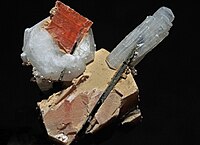
Photo from wikipedia
Abstract Knowledge about the trace element distribution in sulfides is the key for understanding the trace metal inventory of ancient volcanic massive sulfide during the formation of these deposits on… Click to show full abstract
Abstract Knowledge about the trace element distribution in sulfides is the key for understanding the trace metal inventory of ancient volcanic massive sulfide during the formation of these deposits on the seafloor. The distribution of trace metals in sulfides reflects changes in the physicochemical conditions and precipitation processes during precipitation. Hydrothermal black smoker samples or this study originate from the southern Mid-Atlantic (TVG02, TVG06) and can be classified into two types: (1) (Fe-Zn) sulfides consisting predominantly of pyrite and sphalerite, with minor chalcopyrite, isocubanite, and galena and (2) (Fe-Cu) sulfides, which contain mainly pyrite and chalcopyrite, with rare isocubanite and sphalerite. The sulfide samples were analyzed by electron microprobe for major elements, and by laser ablation inductively coupled plasma mass spectrometry and focused ion beam technique and transmission electron microscopy for in situ trace elements. The data reveal complex hydrothermal processes in high- and low- temperature fluids. Colloform and dendritic pyrite from (Fe-Zn) sulfides are enriched in Mn, Tl, As, V, Pb, and Zn and indicate precipitation from low temperature fluids (250-100°C) reflecting a rapid mixture of hydrothermal fluids with seawater. A continuous enrichment of incompatible elements at the interface of growing pyrite with fluid finally leads to the nucleation and precipitation of sphalerite and galena, and results in the enrichment of As, Hg, Pb, Au, Ag, and Cd in sphalerite micro-inclusions which are hosted in colloform pyrite at low temperature. Galena inclusions occur in the pores and the interstices of sphalerite grains and formed by the enrichment of Pb in the hydrothermal fluid at low-temperature ( 300°C) fluids.
Journal Title: Ore Geology Reviews
Year Published: 2020
Link to full text (if available)
Share on Social Media: Sign Up to like & get
recommendations!